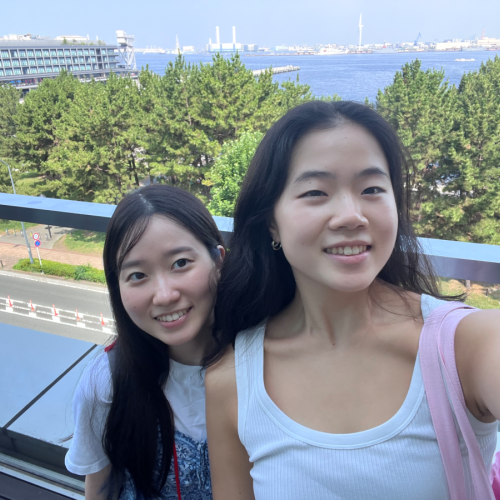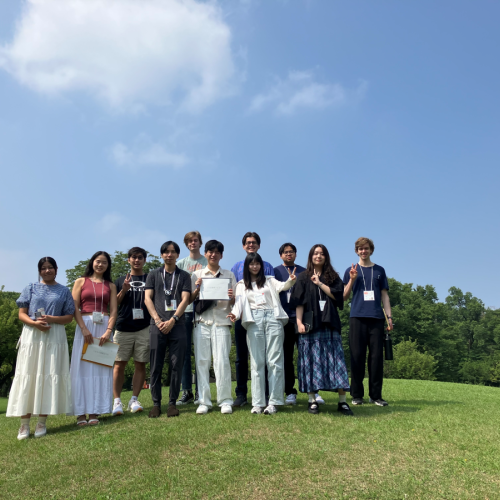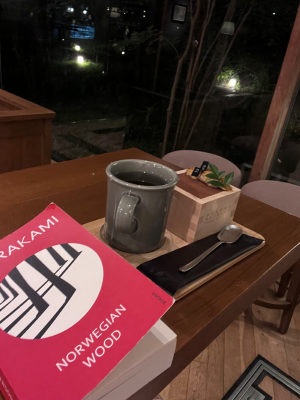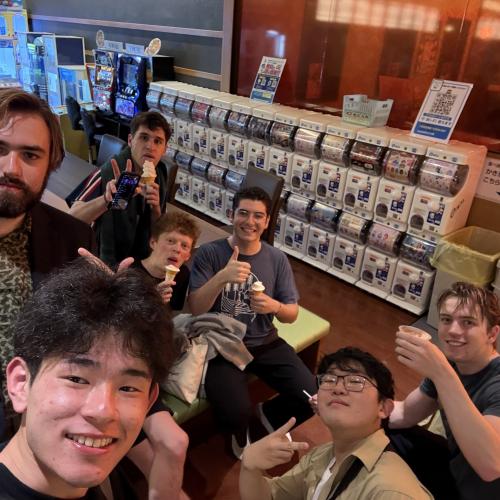"We Explored Japan!" Report from J.LIVE Talk 2024 winners
- Jessica Tang (Georgetown University)
- Andy Hong (University of Virginia)
- Santiago Ravello (George Washington University)
- Reports from past winners
Jessica Tang (Georgetown University), the College Category I Gold award winner studied at International Christian University in Tokyo.
Pikachu on one shoulder, backpack slung over the other, I feel oddly like Ash Ketchum (this is not metaphorical, see Figure 1). As I leave International Christian University to embark on my next adventure, I can’t help but reminisce back on the past three weeks.

Figure 1: Pikachu and I, spotting a wild Snorlax.
So… let’s go back to the beginning.
Pre-pikachu and all. Two days after we moved-in, we had our first field trip. Out of the three options (visiting Tokyo Sky Tree, making food samples, or going to the Cup Noodle Museum), I chose this last one. This was a no-brainer decision for me. My hunch was the others who chose this excursion would be my kind of goofy, so we would get along well. I was right. As we were waiting for our turn to color, I realized we were surrounded by little children…I’m not sure what that says about us. Anyway, on the left are our masterpieces. On the right I’m with Maino-san, an ICU student who became one of my closest friends there.

Picasso Edition

Me & Maino-san Edition
The Monday after our Cup Noodle adventure, Japanese language classes officially began. Every morning, we met for three hours. But, three hours never felt like three hours with them…or it felt shorter because I was often late…anyway.
To Japanese Level 2: y’all were really cool. I send my best wishes to whichever corner of the world you are returning to.
To Ugamochi sensei: thank you for the clarity in your explanations, for the engaging activities, and for your patience with us.

Japanese Level 2 Class — Bakayama edition

Japanese Level 2 Class — Thank you Ugamochi Sensei! edition
During the afternoons, we learned about the following topics: Japanese art, history, anthropology, religion & philosophy, and environment & technology. For each unit, we had an essay. Needless to say, we were kept busy. Every week, we also had a field trip. We visited Miraikan (museum of the future) where we simulated the physical deterioration of aging. Grandma and grandpa, I have renewed sympathy for you. Another week we visited a local temple and learned about the ritual and mindset of Zen Buddhism. In addition to these field trips every week, we had classroom electives. I chose Furoshiki, Aikido, and playing traditional Japanese games. I appreciated the opportunity to engage with different aspects of Japanese culture while meeting new friends from other classes.
On the last full weekend, I booked a solo trip. I ran an obstacle race on Mt. Fuji and enjoyed soaking in an onsen at Hakone after.

My first Spartan Race outside the US

The best banana tiramisu I’ve ever eaten
Of course, not all moments were as tasty. Much of my time was characterized by frustration. Frustration both in learning Japanese and in another skill I was building: dance. Because while perseverance has a positive connotation, perseverance itself meant recognizing the ravine between where I am, where I want to go, and still intentionally making space for joy with patience.
Our three weeks concluded with group final project presentations. My team’s project was titled “Anthropology: The Future of Robots and AI in Japan.” Once I came up with the following topic, I couldn’t not present it.
It was… quite fun.

I had to try Character.AI for research purposes…
After all of us presented, we had the closing ceremony. Ryan-san and I gave a closing speech on behalf of Japanese Level 2, and our class performed the dance to Gen Hoshino’s “Koi.” You definitely did not see me cry after. What even is crying?
As our ISPJ 2025 summer comes to a close, Pikachu and I want to leave everyone with one last message.
We wish you all the best on your next adventure!
Andy Hong (University of Virginia), the College Category II Gold award winner studied at Nanzan University in Nagoya.
It was a pleasure to visit.

From May to August, I studied abroad at Nanzan University’s Center for Japanese Studies (CJS) program in Nagoya.
My situation may be a little unique. Before this program, I had already been studying Japanese independently for several years and even passed the JLPT N1. But despite my prior knowledge of the language, I knew I wanted the chance to live and study in Japan as a college student. This scholarship offered me one of the few opportunities I might have to experience that firsthand.
One of the highlights of my time abroad was reconnecting with friends I had only known online until now. Meeting them in person and traveling across the country (from Aomori to Hiroshima) gave me a chance to experience Japan through their eyes as well as my own. I was struck by how strongly each region expressed its own character, whether through local foods, dialects, or structures. That sense of regional identity left a strong impression on me, and it’s something I wish I could see reflected more in the United States.
Nagoya itself was a wonderful home base. The public transportation system was convenient, the food was incredible (I already miss drenching everything in miso), and the people were welcoming. I noticed that as long as my friends and I spoke in Japanese, we were treated just like anyone else. Perhaps this was partly because Nagoya is not as much of a tourist hub compared to Tokyo or Kyoto, but it gave me a sense of belonging that I deeply appreciated. Of course, I’ll never forget stepping outside each morning into the blazing summer sun, immediately getting drenched in sweat, but trekking forward to the station anyways to go meet my friends.
I am deeply grateful to J.LIVE Talk for their support in helping me arrange my travel accommodations, and to ANA for ensuring that every stage of my journey was comfortable. I am especially grateful to Nanzan for creating an environment where I could learn and grow, and to all the people I met in Japan, whether classmates, professors, friends, or even bus drivers, who helped make my experience so meaningful.
This opportunity has reinvigorated me. It reminded me of why I first fell in love with learning Japanese, and it encouraged me to keep putting myself out into the world, both academically and personally.
Thank you once again for providing such a meaningful opportunity.

Santiago Ravello (George Washington University), the College Category III Gold award winner studied at Naganuma School in Tokyo.
I was extremely thankful for the opportunity to live in Japan while studying at the Naganuma School in Shibuya, Tokyo. I already had experience living in Japan through my time on the JET Program, but I was excited to spend this time in Tokyo, despite knowing how brutal Japanese summers could be. I had never stayed in a share house before, but chose to do so to stretch out my budget as much as possible. It was also convenient to be going to Japan with the J-Live Talk stipend during a time of historically favorable exchange rates from dollars to yen, given the cost-of-living issues making headlines in Japan. I scheduled my trip to give myself a week before and after classes to travel and not worry about attending classes. Even before arriving in Japan, however, I found my schedule book already filling up with trips to visit friends, former colleagues, and network for future opportunities in Japan.

While in Tokyo, I attended the Naganuma School, located in the heart of Shibuya and only a couple of train stops away from my share house. Naganuma’s classes were separated into three categories: academic, conversational, and professional, depending on the student’s goals. I was placed in the highest-level classes for conversational Japanese and was very pleased with the small class size, which had only about ten people. My classmates were mostly from other East Asian countries, with one American and one Canadian student as well. Classes only lasted until the afternoon, which was convenient for meeting friends, sightseeing, or running errands in the evening. Unfortunately, it was so hot that most days, after returning to my share house, I usually couldn’t bring myself to leave the house again until after the sun had set. Being so close to Harajuku and Shinjuku, however, this also offered the chance to witness some Tokyo nightlife on my nightly post-dinner walks.
Class content was broken up to focus on reading, grammar, and vocabulary. Despite already having a very high level of Japanese fluency, the classes served as a useful refresher of certain concepts and introduced some words I was unfamiliar with. What I appreciate most about the classes was the way the teachers would spur conversation between students on various topics, such as our home countries or opinions on selected readings. It both gave dedicated time to practice (mostly) unstructured speaking and allowed the students to get to know each other better. My classmates came from a range of different stages of life, with some simply there to continue their studies, others seeking to improve their Japanese with the goal of job hunting, and others who were already Japanese residents wanting to improve their daily communication abilities. The small class size allowed us to get to know each other quite well as we developed in-jokes and encouraged each other when someone was stumped by a question or reading segment in class.
One of my favorite activities from class was getting through an excerpt of Natsume Soseki’s Wagahai ha Neko Dearu. Although it was a brief reading, I thoroughly enjoyed the end of the assignment when we discussed our interpretations of the content for the breadth of views being shared over such a short piece. I was greatly impressed by my classmates' (and my own) ability to communicate nuanced and thoughtful insights on a piece of literature, and I thought it spoke to the high quality of education offered at the Naganuma School. After completing the reading, we took a class field trip to the Natsume Soseki Memorial Museum in Shinjuku. Having read a bit about the author during class, it was a good way to get to know my classmates better and continue conversations started in class about the reading as we looked at museum displays.
Although my time in Tokyo flew by, I did my best to make the most of the weekends I had there. At the time, I was in the process of applying for the MEXT Scholarship and in contact with potential advisors for my research. The first couple of weekends I was in Japan, I attended academic conferences at both Sophia and Tokyo University. It was my first time attending a mostly Japanese-language academic conference, and it made me realize how far I had come with my Japanese and how much I had left to learn. On other weekends, I was able to travel and attend the Osaka World Expo. It was miserably hot, and everyone was doing their best to stay in the shade as much as possible. I managed to see some interesting displays and enjoy my time before heading back into the city to catch a night bus back to Tokyo. The following weekend, I traveled to Miyagi to visit old colleagues from my time on the JET program. By this time, I was nearly done with my time at Naganuma, but the time I had spent studying Japanese and practicing speaking had prepared me to serve as an interpreter for a delegation from the sister city of the town where I used to work.
The time I spent in Tokyo, Japan, and the Naganuma School, thanks to J-Live Talk, provided me with many opportunities not only to improve my Japanese but to connect with many contacts, old and new. For that reason, I would like to thank my instructors at GWU who helped me prepare for my speech that earned me this trip, and helped arrange the J-Live Talk contest, friends and instructors from the Naganuma School for providing an amazing learning environment, and ANA for making the trip possible through its generous funding. Thanks to this trip, I feel more confident in my Japanese language abilities and advanced my future career prospects concerning Japan.


